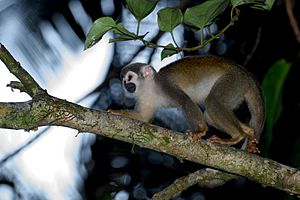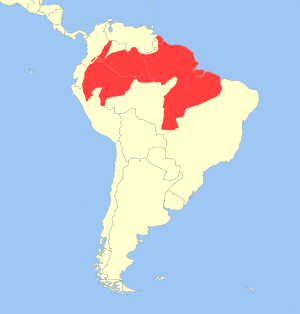Common squirrel monkey facts for kids
Quick facts for kids Common squirrel monkey |
|
|---|---|
 |
|
| Scientific classification | |
| Kingdom: | Animalia |
| Phylum: | Chordata |
| Class: | Mammalia |
| Order: | Primates |
| Suborder: | Haplorhini |
| Infraorder: | Simiiformes |
| Family: | Cebidae |
| Subfamily: | Saimiriinae |
| Genus: | Saimiri |
| Groups included | |
|
|
 |
|
| Geographic range | |
| Cladistically included but traditionally excluded taxa | |
|
|
The Common squirrel monkey is a name used for several small, cute monkey species that live in the warm, tropical parts of South America. For a long time, scientists thought there was just one "common squirrel monkey" species called Saimiri sciureus. But new research showed that this name actually covered at least three, and maybe even four, different species! These include the Guianan squirrel monkey, Humboldt's squirrel monkey, and Collins' squirrel monkey.
Contents
Where Do Squirrel Monkeys Live?
Common squirrel monkeys are mostly found in the Amazon Basin. Before scientists learned there were different species, they thought these monkeys lived in many countries like Brazil, Colombia, Ecuador, French Guiana, Guyana, Peru, Suriname, and Venezuela.
However, after more studies in 2009 and 2015, scientists realized that some groups of monkeys previously called S. sciureus were actually separate species:
- Guianan squirrel monkey, S. sciureus
- Collins' squirrel monkey, S. collinsi
- Humboldt's squirrel monkey, S. cassiquiarensis
Because of these discoveries, the S. sciureus species is now known to live only in Brazil and the Guianas.
Squirrel Monkeys in New Places
Sometimes, squirrel monkeys end up in places they don't naturally live. This can happen if they escape from being pets or from places like zoos.
For example, a group of squirrel monkeys was seen in 2009 in the Tijuca Forest in Rio de Janeiro, Brazil. By 2010, they were seen as an invasive species there. This means they were living in a new area and causing problems, like eating the eggs of endangered birds.
Squirrel monkeys also live in Florida, USA. Several groups have been there since the 1960s. Some escaped from attractions like Silver Springs and Tropic Wonderland. Others came from private estates or parks. These monkeys have managed to survive and have babies in Florida for many years.
Common squirrel monkeys like to live in the middle part of the forest trees. This gives them good cover from birds that might try to hunt them. They can be found in rainforests, savannas, mangroves, or marshlands.
What Do Squirrel Monkeys Eat and How Do They Behave?
What They Eat
Common squirrel monkeys eat both fruits and insects. They especially like berry-like fruits found on branches. When they are kept in zoos, they eat fruits like apples, oranges, grapes, and bananas. They also enjoy vegetables such as lettuce and celery.
Besides plants, squirrel monkeys hunt for insects and small animals like tree frogs. They get most of their water from the food they eat. They also drink from holes in trees and puddles on the ground. If fruit is hard to find, they will drink nectar from flowers.
Squirrel monkeys spend a lot of time looking for food. This keeps them busy and active. If food is too easy to get, like in captivity, they can get bored.
How They Live Together
Common squirrel monkeys live in large groups with many males and females. The main part of the group is made up of adult females and their young. Young monkeys, called juveniles, love to play and explore. But they usually stay close to the adult females.
Adult males act differently depending on the time of year. During the time when babies are born, males are usually quiet. They spend their time traveling and finding food away from the main group. But during mating season, males get bigger, excited, and louder. They try to show off to each other and get close to the females to mate. Females might chase males away, sometimes with the help of other females.
Baby squirrel monkeys grow up fast. Between five and eight months old, they become quite independent. They spend less time with their mothers and can even find food on their own. Young monkeys are very active in the group. They climb, run, explore, and often interact with adult monkeys. Most of the time, babies approach adult females who are not their mothers. Adults usually respond calmly to the babies.
When males grow up, they usually leave their birth groups. They might live alone, join another group, or even hang out with a different monkey species. Females are more likely to stay with their birth groups. But some females do leave after they become adults, often before or after mating season.
Males are usually in charge of the group, but females also have a lot of power. Females can even team up against dominant males. Males rarely form teams with each other.
Daily Habits
Common squirrel monkeys are active during the day. They are usually quiet, but they make loud cries if they are scared. They have different calls for different situations. For example, they make "caws" when defending their territory. They might use "bawls" before or after a fight. "Shrieks" are mainly heard when monkeys are fighting for who is in charge.
Scientists have found that squirrel monkeys' calls are mostly genetic. This means they are born knowing how to make these sounds. Even monkeys who have been deaf since birth can make the same calls. This shows that their calls come from their genes.
Squirrel monkeys live mostly in trees, but they sometimes come down to the ground. Their groups can have anywhere from 12 to 100 monkeys. In very wild forests, groups as large as 500 have been seen!
Conservation Status
Before scientists realized there were different species, common squirrel monkeys were listed as "least concern" by the IUCN. This means they were not in immediate danger. However, they can still be harmed by deforestation, which is when forests are cut down. They have also been caught a lot to be sold as pets or for medical research.
As Pets
Common squirrel monkeys are popular pets because they are curious and playful. However, they need a lot of space and food to stay healthy and happy.
Gallery
-
At the Phoenix Zoo
-
In the walkthrough area of the Woburn Safari Park







